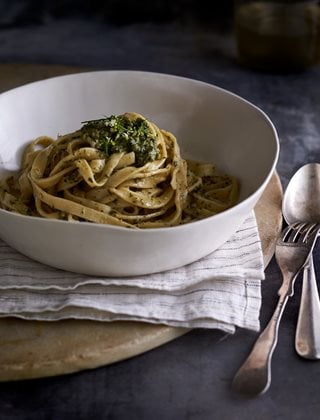Semolina Pasta with Lovage Pesto
Gardener, cook, and forager Laura Silverman shares a recipe for a pesto that embraces the flavor of lovage.The lush leaves of lovage have a flavor similar to celery; it’s similarly verdant, though slightly sweeter.
LOVAGE PESTO
Makes 1 cup
Ingredients
- 2 cups whole lovage leaves, loosely packed
- 1 cup whole mint leaves, loosely packed
- 1 large clove garlic
- ½ cup lightly toasted whole walnuts
- ⅓ cup grated parmesan
- 2 Tbsp fresh lemon juice
- 1 Tbsp lemon zest
- ½ Tbsp nutritional yeast
- 1 tsp honey
- ½ tsp sea salt
- ¾ cups extra virgin olive oil
Instructions
- In the bowl of a food processor, combine the herbs and garlic and process until coarsely chopped.
- Add the walnuts, cheese, lemon juice and zest, nutritional yeast, honey, and salt and process into a fairly smooth paste.
- With the machine still running, drizzle in the olive oil. The result should be unctuous but slightly loose.
- Scrape into a bowl and taste for seasoning, adding more lemon juice or salt as needed.
SEMOLINA PASTA
Makes 4 servings
Ingredients
- 7 oz all-purpose flour
- 7 oz semolina flour
- 4 large eggs, at room temperature
Instructions
- In a bowl, whisk together the flours, then tip onto a counter top or large wooden cutting board, forming a mound.
- Make a large well in the center, then crack the eggs into it. With a fork, gently whisk the eggs together, then use your fingers to gradually draw the dry ingredients into the center, mixing them with the eggs.
- Knead the dough with the heel of your hand for at least 3 minutes, until it’s very smooth. The dough should not feel sticky. If it sticks to your fingers, knead in a small amount of flour, just enough so your fingers come away clean.
- Wrap the dough and let it sit at room temperature for an hour. (You can keep the dough for several hours at room temperature.)
- To roll out the pasta, cut the dough into 6 or 8 pieces on a lightly floured surface.
- Working one piece at a time, fashion each piece into a rough rectangle, then pass it through your pasta machine on the widest setting. Fold dough in half or in thirds and pass it through again. Then fold and pass it through one more time.
- Continue passing the pasta through the machine, closing down the opening of the rollers a few notches with each pass (and dusting them very lightly with all-purpose or semolina flour if the dough is sticking) until you’ve reached the desired thickness.
- Use the pasta cutter attachment to cut the sheets into fettucine.
- If you’re not going to cook it right away, dust the pasta with semolina flour to keep it from sticking and lay it on a semolina-dusted baking sheet until ready to boil.
This bonus content accompanies “First Harvest”—an article about two early season crops: lovage and rhubarb—in the Winter 2017 issue of Garden Design magazine.

